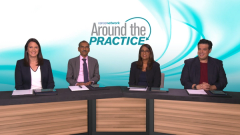
Patient Case 3: A 65-Year-Old Woman With Relapsed Multiple Myeloma
After reviewing their third patient case, expert hematologist-oncologists highlight the treatment armamentarium for relapsed/refractory multiple myeloma.
Episodes in this series

Transcript:
Sundar Jagannath, MD: Dr Richter, would you present your case of relapsed and refractory myeloma and how you managed it?
Joshua Richter, MD: Absolutely. This is a case of a 65-year-old [woman] with IgA [immunoglobulin A] lambda plus lambda multiple myeloma. She was originally diagnosed in 2011 with Durie-Salmon stage IIIA disease, a normal karyotype. She began her induction therapy with bortezomib and dexamethasone, which was later enhanced to VCD [bortezomib, cyclophosphamide and dexamethasone], where she achieved a VGPR [very good partial response]. This was followed by VRD [bortezomib, lenalidomide and dexamethasone] and, ultimately, a stem cell transplant in June 2012. She then went on to lenalidomide maintenance from November 2012 to March 2014, when, unfortunately, she began to have a number of relapses. She subsequently went on to therapies with VRD, followed by panobinostat with Len-Dex [lenalidomide and dexamethasone], followed by Dara-Pom-Dex [daratumumab plus pomalidomide and dexamethasone], followed by carfilzomib and ibrutinib, and then selinexor. At [this] point, in 2017, she required debulking with VD [bortezomib and dexamethasone] set and had a salvage autologous transplant with carmustine and melphalan. This was followed by pazopanib maintenance on a clinical study. Unfortunately, she relapsed from this in 2018. At that time she was deemed eligible for one of our clinical trials with a BCMA [B-cell maturation antigen]–targeting bispecific antibody. She received her bispecific antibody and completed her cycle 1 day 1 infusion at 13:25. At the time, her baseline vital signs were stable, with a blood pressure of 132/69 [mm Hg], heart rate of 80 [beats/min], SpO2 [oxygen saturation] 99% on room air, [and] ICE [Immune Effector Cell–Associated Encephalopathy] score of 10/10. Her inflammatory markers—CRP [C-reactive protein] and ferritin—were within normal limits at 5.1 [mg/L] and 42 [ng/mL], respectively, and the patient was without complaints. Approximately 9 to 10 hours later, at 22:05, she had a low-grade temperature of 100.2 °F, blood pressure maintained at 130/70 [mm Hg], heart rate of 93 [beats/min], SpO2 98% on room air, [and] still with an ICE of 10/10. The patient reported feeling a little warm, but otherwise without complaints. However, about an hour and a half later, at 23:44, her temperature rose to 102.1 °F, [her] blood pressure was a little bit lower at 102/55 [mm Hg], she was tachycardic at 118 [beats/min], SpO2 94% on room air, and still with an ICE of 10/10, but at this time she felt warm and began having mild rigors, and inflammatory markers were somewhat elevated, with a CRP of 30.7 [mg/L] and ferritin of 69 [ng/mL]. At this time we determined that she was having cytokine release syndrome [CRS] that warranted intervention. We administered tocilizumab at 8 mg/kg, acetaminophen 1000 mg, and intravenous fluid. Following this, on cycle 1 day 2 at 2:30 am, her temperature had gone back down to 97.8 °F, [her] blood pressure was somewhat improved at 116/72 [mm Hg], heart rate of 96 [beats/min], SpO2 98% on room air, [and] ICE 10/10, and the patient reported feeling clinically better and was without complaint. Subsequent inflammatory markers later that day showed a CRP slightly downtrending at 21.6 [mg/L] and ferritin of 67 [ng/mL]. The patient was ultimately discharged from the hospital on cycle 1 day 4 without subsequent manifestations of CRS. The patient went on to achieve a stringent complete remission on clinical study; however, after 14 months she ended up having relapsed disease and was placed on alternative therapy.
Sundar Jagannath, MD: That is a very interesting case. Could you describe how the bispecific antibodies work? Then we’ll follow up with the CRS mechanism and management.
Joshua Richter, MD: Absolutely. I am a huge fan of bispecific antibodies because they are off-the-shelf. We recognize our immune system is 1 of the best cancer fighters, and bispecifics enhance that. And we’re all familiar with monoclonal antibodies like rituximab and daratumumab; 1 arm grabs onto the cancer cell and tries to kill it. But bispecifics have 2 arms; 1 arm grabs onto the cancer cell, the other grabs onto our own T cells and activates them to attack the cancer. [It’s a] kind of “myeloma Thunderdome,” where you get the T cell and myeloma cell in 1 room. Two enter but only 1 leaves, and that’s hopefully the triumphant T cell. This is really great at upregulating our body’s immune system and inflammatory markers to engender cell killing.
Sundar Jagannath, MD: This brings me back to CAR [chimeric antigen receptor] T cells. Dr Richard, you also get a cytokine storm following CAR T-cell therapy. I saw in this particular patient she developed CRS. Roughly, she got it around 11:30 am and finished the infusion, but ran into trouble 12 hours later around 11:00 pm, and you managed her CRS with toci [tocilizumab].Can you tell me in the CAR T situation how the CRS is and how is the management there?
Shambavi Richard, MD: Interestingly, for CAR T [-cell therapies], because there are so many different products out there, the timing of the CRS is very product specific, first of all. We now have 2 commercially approved [CAR-T] products. In the case of ide-cel [idecabtagene vicleucel], we actually start seeing CRS on the first day post infusion, whereas with cilta-cel [ciltacabtagene autoleucel], we see it at a median of approximately 7 days. So, the timing is very different. Secondly, when you compare bispecifics and CAR Ts, the frequency of CRS is generally greater with CAR Ts; also, the severity may be a little [higher] with CAR Ts as opposed to bispecifics. So, the timing is different, frequency is different, and severity is different; but essentially, CRS is CRS. Management [starts when the patient develops a] fever, which we call grade 1 CRS; just the fever and not too much else going on. I tend to start giving the toci sooner rather than later because we want to do a couple of things. We want to ward off worsening CRS, and we want to also, hopefully, mitigate the risk of subsequent neurotoxicity and things like that. So, [those are], in general, some of the differences in CRS between CAR T and bispecifics.
Sundar Jagannath, MD: If I’m hearing you correctly, the CRS with CAR T is more intense. And CAR T-cell therapy is usually selected for fitter patients [awaiting] transplant [who are] somewhat more robust, physically and cardiovascularly. But, if I understand the 2 of you, you would be much more willing to give a bispecific antibody to an older gentleman, [say,] 80 years old, and [would] choose CAR T for a 60-year-old. Is that a fair statement?
Shambavi Richard, MD: In general, I would say that is fair. Certainly, we’ve done CAR T [therapy] for older patients. Some of the things we’ve seen, if the disease is rapidly progressive or [if there is a] large disease burden we are unable to get down, it might be a little bit safer to do a bispecific antibody than to do a CAR T. On the other hand, [for] younger, fitter patients, [because] the disease has been pretty refractory to a lot of other treatments, CAR T is a good option. But the disease can be controlled to some extent, so you are not an extremist when you are coming in for the CAR T. I think those are the patients [for whom] you may prefer a CAR T to a bispecific.
Transcript edited for clarity.
Newsletter
Stay up to date on recent advances in the multidisciplinary approach to cancer.










